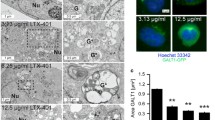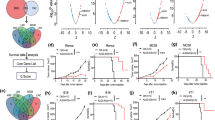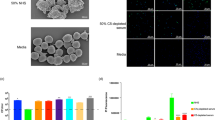Abstract
The use of α(1,3)galactosyltransferase (αGT) as a method of inducing hyperacute rejection of tumors has been gaining interest recently. However, the approach is based in part on the sensitivity of each tumor line to the effects of complement lysis. Tumors expressing complement resistance factors such as membrane cofactor (CD46), decay accelerating factor (CD55) and protectin (CD59) have been shown to be more resistant to complement mediated lysis. Anchored to the membrane by a glycosylphosphoinositol moiety (GPI-anchored), CD55 and CD59 can be cleaved by Bacillus thuringiensis phosphatidylinositol-specific phospholipase C (PIPLC). Complement resistant A549 human lung carcinoma cells were engineered to express both the murine αGT gene and the B. thuringiensis PIPLC gene to alleviate complement resistance and enhance αgal-mediated cancer killing. The PIPLC native signal sequence was replaced with the human epidermal growth factor signal sequence, EGFssPIPLC, to induce secretion from A549. Expression of EGFssPIPLC resulted in complete removal of CD55 and CD59 while sparing the non-GPI-anchored CD46. Results demonstrated that A549 cells transduced with two recombinant retroviral vectors carrying the αGT and EGFssPIPLC genes expressed high levels of αgal epitope and exhibited a 5-fold increase in sensitivity to anti-αgal mediated complement lysis.







Similar content being viewed by others
References
Bastide C, Maroc N, Bladou F, Hassoun J, Maitland N, Mannoni P, Bagnis C (2003) Expression of a model gene in prostate cancer cells lentivirally transduced in vitro and in vivo. Prostate Cancer Prostatic Dis 6:228–234
Beck C, Uramoto H, Boren J, Akyurek LM (2004) Tissue-specific targeting for cardiovascular gene transfer. Potential vectors and future challenges. Curr Gene Ther 4:457–467
Brasoveanu LI, Altomonte M, Fonsatti E, Colizzi F, Coral S, Nicotra MR, Cattarossi I, Cattelan A, Natali PG, Maio M (1996) Levels of cell membrane CD59 regulate the extent of complement-mediated lysis of human melanoma cells. Lab Invest 74:33–42
Brasoveanu LI, Altomonte M, Gloghini A, Fonsatti E, Coral S, Gasparollo A, Montagner R, Cattarossi I, Simonelli C, Cattelan A et al (1995) Expression of protectin (CD59) in human melanoma and its functional role in cell- and complement-mediated cytotoxicity. Int J Cancer 61:548–556
Clark PR, Stopeck AT, Brailey JL, Wang Q, McArthur J, Finer MH, Hersh EM (1999) Polycations and cationic lipids enhance adenovirus transduction and transgene expression in tumor cells. Cancer Gene Ther 6:437–446
Clark PR, Stopeck AT, Ferrari M, Parker SE, Hersh EM (2000) Studies of direct intratumoral gene transfer using cationic lipid-complexed plasmid DNA. Cancer Gene Ther 7:853–860
Cooper DK, Good AH, Koren E, Oriol R, Malcolm AJ, Ippolito RM, Neethling FA, Ye Y, Romano E, Zuhdi N (1993) Identification of alpha-galactosyl and other carbohydrate epitopes that are bound by human anti-pig antibodies: relevance to discordant xenografting in man. Transpl Immunol 1:198–205
Czermak BJ, Lentsch AB, Bless NM, Schmal H, Friedl HP, Ward PA (1999) Synergistic enhancement of chemokine generation and lung injury by C5a or the membrane attack complex of complement. Am J Pathol 154:1513–1524
Daugherty S, Low MG (1993) Cloning, expression, and mutagenesis of phosphatidylinositol-specific phospholipase C from Staphylococcus aureus: a potential staphylococcal virulence factor. Infect Immun 61:5078–5089
Galili U, Mandrell RE, Hamadeh RM, Shohet SB, Griffiss JM (1988) Interaction between human natural anti-alpha-galactosyl immunoglobulin G and bacteria of the human flora. Infect Immun 56:1730–1737
Galili U, Rachmilewitz EA, Peleg A, Flechner I (1984) A unique natural human IgG antibody with anti-alpha-galactosyl specificity. J Exp Med 160:1519–1531
Galili U, Shohet SB, Kobrin E, Stults CL, Macher BA (1988) Man, apes, and Old World monkeys differ from other mammals in the expression of alpha-galactosyl epitopes on nucleated cells. J Biol Chem 263:17755–17762
Galili U, Swanson K (1991) Gene sequences suggest inactivation of alpha-1,3-galactosyltransferase in catarrhines after the divergence of apes from monkeys. Proc Natl Acad Sci USA 88:7401–7404
Good AH, Cooper DK, Malcolm AJ, Ippolito RM, Koren E, Neethling FA, Ye Y, Zuhdi N, Lamontagne LR (1992) Identification of carbohydrate structures that bind human antiporcine antibodies: implications for discordant xenografting in humans. Transplant Proc 24:559–562
Griffith OH, Ryan M (1999) Bacterial phosphatidylinositol-specific phospholipase C: structure, function, and interaction with lipids. Biochim Biophys Acta 1441:237–254
Hamadeh RM, Jarvis GA, Galili U, Mandrell RE, Zhou P, Griffiss JM (1992) Human natural anti-Gal IgG regulates alternative complement pathway activation on bacterial surfaces. J Clin Invest 89:1223–1235
Henrik Nielsen AK (1998) Prediction of signal peptides and signal anchors by a hidden Markov model. In: Proceedings of the sixth international conference on intelligent systems for molecular biology. AAAI Press, Menlo Park, California, pp 122–130
Hlavaty J, Portsmouth D, Stracke A, Salmons B, Gunzburg WH, Renner M (2004) Effects of sequences of prokaryotic origin on titer and transgene expression in retroviral vectors. Virology 330:351–360
Jager U, Takeuchi Y, Porter C (1999) Induction of complement attack on human cells by Gal(alpha1,3)Gal xenoantigen expression as a gene therapy approach to cancer. Gene Ther 6:1073–1083
Joziasse DH, Shaper JH, Jabs EW, Shaper NL (1991) Characterization of an alpha 1-3-galactosyltransferase homologue on human chromosome 12 that is organized as a processed pseudogene. J Biol Chem 266:6991–6998
Joziasse DH, Shaper NL, Kim D, Van den Eijnden DH, Shaper JH (1992) Murine alpha 1,3-galactosyltransferase. A single gene locus specifies four isoforms of the enzyme by alternative splicing. J Biol Chem 267:5534–5541
Junnikkala S, Hakulinen J, Jarva H, Manuelian T, Bjorge L, Butzow R, Zipfel PF, Meri S (2002) Secretion of soluble complement inhibitors factor H and factor H-like protein (FHL-1) by ovarian tumour cells. Br J Cancer 87:1119–1127
Junnikkala S, Hakulinen J, Meri S (1994) Targeted neutralization of the complement membrane attack complex inhibitor CD59 on the surface of human melanoma cells. Eur J Immunol 24:611–615
Larsen RD, Rajan VP, Ruff MM, Kukowska-Latallo J, Cummings RD, Lowe JB (1989) Isolation of a cDNA encoding a murine UDPgalactose:beta-d-galactosyl- 1,4-N-acetyl-d-glucosaminide alpha-1,3-galactosyltransferase: expression cloning by gene transfer. Proc Natl Acad Sci USA 86:8227–8231
LaTemple DC, Abrams JT, Zhang SY, Galili U (1999) Increased immunogenicity of tumor vaccines complexed with anti-Gal: studies in knockout mice for alpha1,3galactosyltransferase. Cancer Res 59:3417–3423
Link CJ Jr, Seregina T, Atchison R, Hall A, Muldoon R, Levy JP (1998) Eliciting hyperacute xenograft response to treat human cancer: alpha(1,3) galactosyltransferase gene therapy. Anticancer Res 18:2301–2308
Mengaud J, Braun-Breton C, Cossart P (1991) Identification of phosphatidylinositol-specific phospholipase C activity in Listeria monocytogenes: a novel type of virulence factor? Mol Microbiol 5:367–372
Miller AD, Rosman GJ (1989) Improved retroviral vectors for gene transfer and expression. Biotechniques 7:980–982, 984–986, 989–990
Nagao S, Kuriyama S, Okuda H, Tominaga K, Nakatani T, Tsujinoue H, Yoshiji H, Fukui H (2001) Adenovirus-mediated gene transfer into tumors: evaluation of direct readministration of an adenoviral vector into subcutaneous tumors of immunocompetent mice. Int J Oncol 18:57–65
Noureddini SC, Curiel DT (2005) Genetic targeting strategies for adenovirus. Mol Pharm 2:341–347
Parker CJ (1996) Molecular basis of paroxysmal nocturnal hemoglobinuria. Stem Cells 14:396–411
Platt JL, Vercellotti GM, Dalmasso AP, Matas AJ, Bolman RM, Najarian JS, Bach FH (1990) Transplantation of discordant xenografts: a review of progress. Immunol Today 11:450–456; discussion 456–457
Pruitt SK, Kirk AD, Bollinger RR, Marsh HC, Jr., Collins BH, Levin JL, Mault JR, Heinle JS, Ibrahim S, Rudolph AR, et al (1994) The effect of soluble complement receptor type 1 on hyperacute rejection of porcine xenografts. Transplantation 57:363–370
Royal RE, Kershaw MH, Reeves ME, Wang G, Daly T, Treisman J, Lam J, Hwu P (2002) Increased functional expression of transgene in primary human lymphocytes using retroviral vectors modified with IRES and splicing motifs. Gene Ther 9:1085–1092
Sandrin MS, McKenzie IF (1994) Gal alpha (1,3)Gal, the major xenoantigen(s) recognised in pigs by human natural antibodies. Immunol Rev 141:169–190
Sandrin MS, Vaughan HA, Dabkowski PL, McKenzie IF (1993) Anti-pig IgM antibodies in human serum react predominantly with Gal(alpha 1–3)Gal epitopes. Proc Natl Acad Sci USA 90:11391–11395
Sozzani S, Sallusto F, Luini W, Zhou D, Piemonti L, Allavena P, Van Damme J, Valitutti S, Lanzavecchia A, Mantovani A (1995) Migration of dendritic cells in response to formyl peptides, C5a, and a distinct set of chemokines. J Immunol 155:3292–3295
Tsuji RF, Kawikova I, Ramabhadran R, Akahira-Azuma M, Taub D, Hugli TE, Gerard C, Askenase PW (2000) Early local generation of C5a initiates the elicitation of contact sensitivity by leading to early T cell recruitment. J Immunol 165:1588–1598
Unfer RC, Hellrung D, Link CJ Jr (2003) Immunity to the α(1,3)galactosyl epitope provides protection in mice cahllenged with colon cancer cells expressing α(1,3)galactosyl-transferase: a novel suicide gene for cancer gene therapy. Cancer Res 63:987–993
Varsano S, Rashkovsky L, Shapiro H, Ophir D, Mark-Bentankur T (1998) Human lung cancer cell lines express cell membrane complement inhibitory proteins and are extremely resistant to complement-mediated lysis; a comparison with normal human respiratory epithelium in vitro, and an insight into mechanism(s) of resistance. Clin Exp Immunol 113:173–182
Vaughan HA, Loveland BE, Sandrin MS (1994) Gal alpha(1,3)Gal is the major xenoepitope expressed on pig endothelial cells recognized by naturally occurring cytotoxic human antibodies. Transplantation 58:879–882
Yang C, Jones JL, Barnum SR (1993) Expression of decay-accelerating factor (CD55), membrane cofactor protein (CD46) and CD59 in the human astroglioma cell line, D54-MG, and primary rat astrocytes. J Neuroimmunol 47:123–132
Young WB, Link CJ, Jr. (2000) Chimeric retroviral helper virus and picornavirus IRES sequence to eliminate DNA methylation for improved retroviral packaging cells. J Virol 74:5242–5249
Acknowledgements
The authors thank Dr. Ming Tsai of Ohio State University for providing the B. thuringiensis PIPLC gene and Dr. Mary Roberts of Boston college for her helpful discussions. This work was funded by a grant from the Department of Defense Army Breast Cancer Foundation (#DAMD17-00-1-0292) and the Susan G. Komen Breast Cancer Foundation (#99–3215).
Author information
Authors and Affiliations
Corresponding author
Rights and permissions
About this article
Cite this article
Hellrung, D.J., Kisselev, S. & Link, C.J. Co-expression of α(1,3)galactosyltransferase and Bacillus thuringiensis PIPLC enhances hyperacute rejection of tumor cells. Cancer Immunol Immunother 56, 25–34 (2007). https://doi.org/10.1007/s00262-006-0163-5
Received:
Accepted:
Published:
Issue Date:
DOI: https://doi.org/10.1007/s00262-006-0163-5




